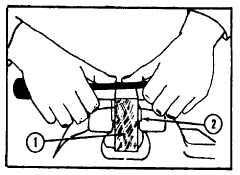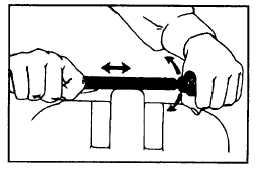TM 9-243
SAFETY
1. If a file is designed to be used with a handle, do not
attempt to use it without the handle. Holding the sharp
tang in your hand while filing can cause serious injury.
2. Do not use a file for prying. The tang end is soft and
it bends easily. The body of the file is hard and very
brittle. A light bending force will cause it to snap.
3. Do not hammer on a file. This is very dangerous
because the file may shatter.
USING A FILE
SELECTING PROPER FILE
1. For heavy, rough cutting, use a large, coarse,
double-cut file.
2. For finishing cuts, use a second or smooth-cut,
single-cut file.
3. When working on cast iron, start with a bastard-cut
file and finish with a second-cut file.
4. When filing soft metal, start with a second-cut file
and finish with a smooth-cut file.
5. When filing hard steel, start with a smooth-cut file
and finish with a dead-smooth file.
6. When filing brass or bronze, start with a bastard-cut
file and finish with a second or smooth-cut file.
7. When filing aluminum, lead, or babbitt metal, use a
standard-cut curved-tooth file.
8. For small work, use a short file. For medium sized
work, use an 8-inch file. For large work, use a file that is
most convenient.
METHOD OF FILING
1. Clamp the work (1) securely in a vise so that the area
to be filed is horizontal and is parallel to and projecting
slightly above the vise jaws (2).
2. Hold the file handle in one hand, thumb on top, and
hold the end of the file with the fingers of the other
hand.
3. When filing hard metals, apply pressure on the
forward stroke only. Unless the file is lifted from the
work on the return stroke, it will become dull much
sooner than it should.
Change 2 28-4



